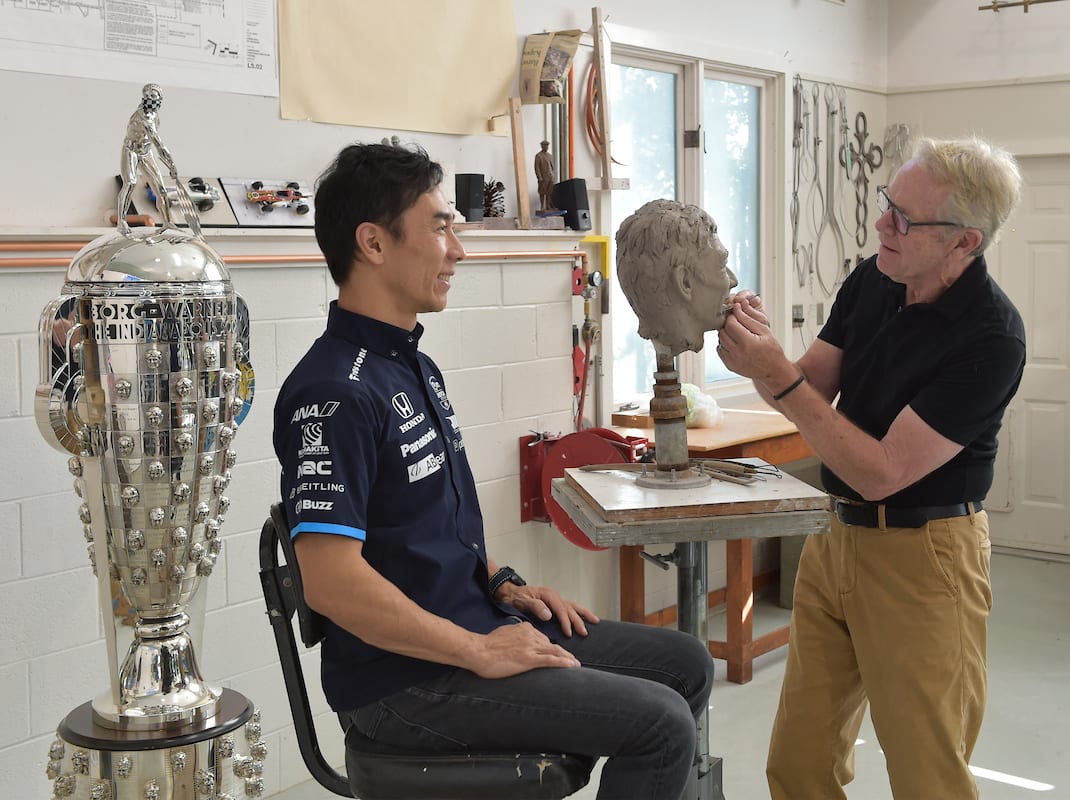According to Behrends, Sato has a great face because of strong bone structure and a great smile.
“He smiles with his entire face,” Behrends said. “He’s a good image to do.”
The next step in the process if far from the final step. After creating the face in clay, Behrends will used the loft-wax casting technique to create a mold. That mold will serve as the cast for the sterling silver bas-relief image that is the size of an egg.
The egg-shaped bas-relief image is what is attached to the Borg-Warner Trophy and will be unveiled during the offseason at the Indianapolis Motor Speedway Museum.
“It’s the same technique I use for my over-life-size sculptures,” Behrends said. “I create it in clay, and it ends up being a loft wax casting, not in bronze like the big ones but in sterling silver. It’s the same process.
“What I have done over the years is put in an interim stage between the clay and the loft-wax part, which is a high-density plaster, which allows me to sharpen detail and smooth surfaces, which ends up looking better in sterling silver.
“It’s hard to grasp but think of it as a series of positives and negatives,” Behrends said. “The clay is the first positive. From that, I make a mold and the mold is negative. It’s poured over the clay and makes a negative of that image. In that mold, you pour the high-density plaster, that’s the next positive. Once I’ve finished that, then I do another negative, another mold. In that mold, the wax is poured and that is the third positive. The fourth positive is the sterling silver image.

“I use the life-size clay and refer to it every now and then when I’m making the smaller size. I basically do it again, which isn’t as repetitive as it sounds. I’ve done this for 47 years and when I’m working on the clay, I’m memorizing the face so I can execute it. This makes it much quicker and better for me to have learned the face in the clay process.”
It’s a labor of love for Behrends, who was contacted by BorgWarner in 1990 to take over as the sculptor.
“I like to think most of them are friends,” Behrends said of the Indy 500 winners. “We see each other at the track and greet each other. Everyone that I see and have done before are very gracious and greet me.
“Arie Luyendyk has been somewhat special because in 1990 when I did his image, he called me on the phone and told me how much he liked it. And again in 1997. If I see him at the track, he will come up to me and we’ll greet each other.
“All of them that I have done, if I see them, it seems like a special relationship.
“I like that. I feel very privileged — I’m the guy they want to see on Monday morning after the race.”
Sato is face No. 31 for Behrends. Although the winner of this year’s Indianapolis 500 had to celebrate in victory lane by wearing a hospital mask because of the COVID-19 pandemic, there was never any discussion to having a mask on Sato’s image on the trophy.
“I wouldn’t want to do it because it would hide some of his best features — that wonderful smile and the real expressive part of his face would be hidden,” Behrends explained. “I would have been against it.
“My goal is to have it recognizable from a distance so that when it’s in the museum, someone 10 feet away can recognize the driver. At this scale, you have to over-emphasize the expression of joy and the likeness. I think hopefully I’ve gotten better at that over the years.”
Sato is the 20th driver to win the famed race more than once in a career.
Behrends is also a major part of Indianapolis 500 history as fans will still be able to marvel at his work on the trophy, long after he puts away his sculpting tools.
“That’s something I love,” Behrends said. “The fact that I have been able to do this, this many years and put my small mark on the trophy and the history of this race is a special feeling. It’s really a privilege for me and I’m really grateful to be a part of it.”
